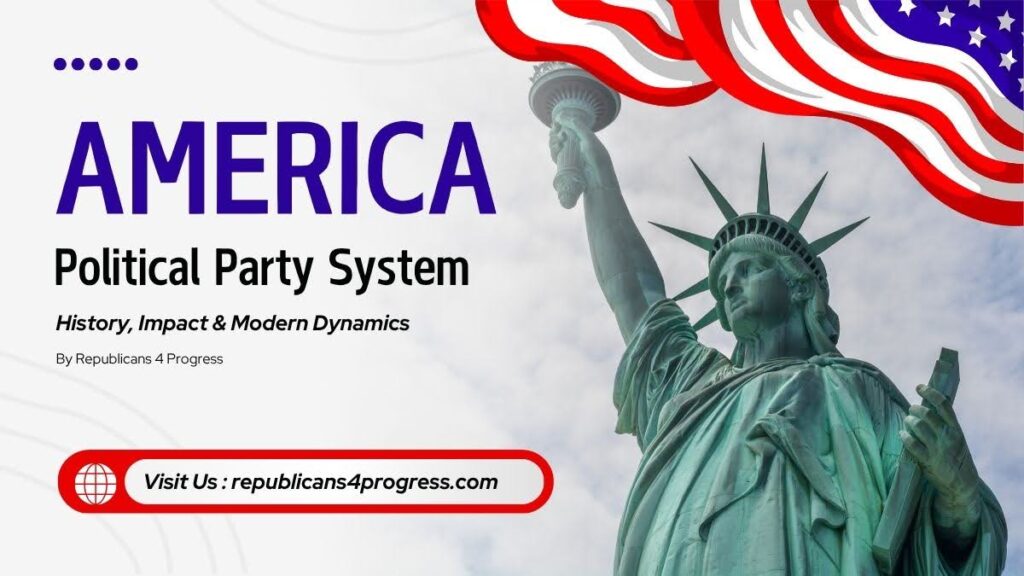
The American Political Party System is central to how democracy functions in the United States. From influencing national elections to shaping public policy, political parties guide the nation’s leadership choices and legislative outcomes. To truly grasp American governance, it’s crucial to understand this system—its foundations, transformations, and current dynamics.
For movements like Republicans 4 Progress, this knowledge goes beyond theory—it informs action. As reformers within the Republican Party, we are committed to renewing conservative values through innovation, integrity, and inclusive dialogue. Understanding the evolution of America’s party structure empowers us to drive meaningful, future-focused change.
Historical Overview of the American Political Party System
Though the U.S. Constitution makes no mention of political parties, they emerged in the late 18th century. The early divide was between Federalists, who favored a strong central government, and Democratic-Republicans, who championed states’ rights.
By the 1820s, new divisions birthed the Democratic Party under Andrew Jackson, while the Whigs opposed his populist policies. The slavery debate led to the Whigs’ collapse and the formation of the Republican Party in the 1850s, rooted in anti-slavery ideals.
Key milestones in party evolution:
- 1930s: The New Deal Coalition strengthens Democratic support among working-class voters.
- 1960s–70s: The Southern Strategy reshapes Republican influence in the South.
- 1990s–present: Rise of independents and alternative voices like Ross Perot signal voter dissatisfaction with the two-party dominance.
These shifts reflect the changing fabric of American identity and national priorities.
Related Read: Democracy in America: The Core of United States Politics
Impact of the American Political Party System on Governance
The American Political Party System shapes how laws are passed, leaders are elected, and public sentiment is represented. It organizes debate, structures elections, and connects citizens to government. Yet, it also brings significant challenges:
- Polarization: According to Pew Research, 63% of Americans see “strong conflicts” between Democrats and Republicans, up from 47% in 2012.
- Gridlock: Increasing ideological divides make bipartisan legislation rare.
- Public Distrust: Heightened partisanship has eroded institutional trust.
At Republicans 4 Progress, we aim to counter this trend by supporting moderate voices and championing pragmatic solutions. Responsible parties can foster both stability and reform when guided by principles, not partisanship.
Modern Dynamics of the American Political Party System
Here’s the “Modern Dynamics of the American Political Party System” section reformatted into a clear, easy-to-read table format:
| Dynamic | Description | Implication | Republicans 4 Progress Perspective |
| Technology & Social Media | Platforms like X (Twitter), Facebook, and TikTok have become dominant channels for political communication. | Direct access to voters increases transparency but also heightens polarization and spreads misinformation. | Support responsible use of digital tools for civic engagement and fact-based dialogue. |
| Shifting Demographics | Millennials and Gen Z now represent a significant voting bloc with progressive policy priorities. | Parties must evolve to stay relevant, especially on issues like climate change, equity, and innovation. | Promote modern Republican values that resonate with a new generation of voters. |
| Rise of Independents | 43% of Americans now identify as political independents (Gallup, 2023). | Traditional party loyalty is weakening; there’s greater demand for centrist, solution-focused leadership. | Embrace pragmatic, bipartisan approaches to governance. |
| Suburban & Swing Voters | Voters in suburban and swing districts have outsized influence in national elections. | Winning support requires adaptability, nuanced messaging, and coalition-building. | Advance inclusive conservative policies that appeal across party lines. |
| Decline of Traditional Media Gatekeeping | Politicians and activists communicate directly with the public via social platforms. | Bypasses traditional filters, but often sacrifices depth and civility. | Encourage thoughtful, respectful discourse in both digital and real-world forums. |
Conclusion: Future Perspectives and the Role of Republicans 4 Progress
The American Political Party System is a living institution, constantly evolving with societal values and historical currents. As we face new challenges—from digital misinformation to generational shifts—our political frameworks must evolve.
Republicans 4 Progress is dedicated to renewing conservatism with principle, vision, and civic purpose. We believe in fiscal responsibility, liberty, and national security—but also in compassion, collaboration, and reform.
Now more than ever, we invite you to join this movement. Explore how you can get involved, read our policy priorities, and become part of a growing coalition that believes the future of the Republican Party—and American democracy—depends on progress.
🔗 Visit Republicans4Progress.com to learn more.
Frequently Asked Questions (FAQs):
1. What is the American Political Party System?
It refers to the structure of political competition in the U.S., primarily between Democrats and Republicans. It includes platforms, ideologies, and electoral processes that define governance.
2. Why does the U.S. have a two-party system?
The winner-takes-all electoral system discourages third-party success, reinforcing the dominance of Democrats and Republicans.
3. How has it evolved over time?
From the early Federalists to today’s polarized parties, the system has reflected social, economic, and regional transformations.
4. What are its pros and cons?
While it fosters stability and accountability, it also encourages division and reduces space for centrist ideas.
5. Can progressive voices exist within the GOP?
Yes. Movements like Republicans 4 Progress prove that reform is possible through evidence-based policy, civil dialogue, and inclusivity.